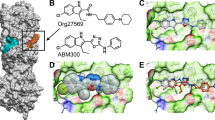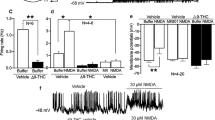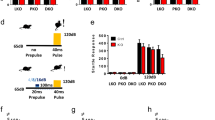Abstract
Cannabis-induced acute psychotic-like states (CIAPS) represent a growing health issue, but their underlying neurobiological mechanisms are poorly understood. The use of antipsychotics and benzodiazepines against CIAPS is limited by side effects and/or by their ability to tackle only certain aspects of psychosis. Thus, safer wide-spectrum treatments are currently needed. Although the blockade of cannabinoid type-1 receptor (CB1) had been suggested as a therapeutical means against CIAPS, the use of orthosteric CB1 receptor full antagonists is strongly limited by undesired side effects and low efficacy. The neurosteroid pregnenolone has been recently shown to act as a potent endogenous allosteric signal-specific inhibitor of CB1 receptors. Thus, we tested in mice the potential therapeutic use of pregnenolone against acute psychotic-like effects of Δ9-tetrahydrocannabinol (THC), the main psychoactive component of cannabis. We found that pregnenolone blocks a wide spectrum of THC-induced endophenotypes typically associated with psychotic-like states, including impairments in cognitive functions, somatosensory gating and social interaction. In order to capture THC-induced positive psychotic-like symptoms (e.g. perceptual delusions), we adapted a behavioral paradigm based on associations between different sensory modalities and selective devaluation, allowing the measurement of mental sensory representations in mice. Acting at hippocampal CB1 receptors, THC impaired the correct processing of mental sensory representations (reality testing) in an antipsychotic- and pregnenolone-sensitive manner. Overall, this work reveals that signal-specific inhibitors mimicking pregnenolone effects can be considered as promising new therapeutic tools to treat CIAPS.
This is a preview of subscription content, access via your institution
Access options
Subscribe to this journal
Receive 12 print issues and online access
$259.00 per year
only $21.58 per issue
Buy this article
- Purchase on Springer Link
- Instant access to full article PDF
Prices may be subject to local taxes which are calculated during checkout





Similar content being viewed by others
References
United Nations Office on Drugs and Crime. World Drug Report 2014.
Wilkinson ST, Radhakrishnan R, D'Souza DC . Impact of Cannabis use on the development of psychotic disorders. Curr Addict Rep 2014; 1: 115–128.
Radhakrishnan R, Wilkinson ST, D'Souza DC . Gone to pot—a review of the association between Cannabis and psychosis. Front Psychiatry 2014; 22: 5–54.
Moore TH, Zammit S, Lingford-Hughes A, Barnes TR, Jones PB, Burke M et al. Cannabis use and risk of psychotic or affective mental health outcomes: a systematic review. Lancet 2007; 370: 319–328.
Fakhoury M . Role of the endocannabinoid system in the pathophysiology of schizophrenia. Mol Neurobiol 2016; 54: 768–778.
Rubino T, Parolaro D . The impact of exposure to cannabinoids in adolescence: insights from animal models. Biol Psychiatry 2015; 3223: 00643–00645.
Green B, Kavanagh D, Young R . Being stoned: a review of self-reported cannabis effects. Drug Alcohol Rev 2003; 22: 453–460.
D'Souza DC, Sewell RA, Ranganathan M . Cannabis and psychosis/schizophrenia: human studies. Eur Arch Psychiatry Clin Neurosci 2009; 259: 413–431.
Leweke FM, Koethe D . Cannabis and psychiatric disorders: it is not only addiction. Addict Biol 2008; 13: 264–275.
D’Souza DC, Perry E, MacDougall L, Ammerman Y, Cooper T, Wu YT et al. The psychotomimetic effects of intravenous delta-9-tetrahydrocannabinol in healthy individuals: implications for psychosis. Neuropsychopharmacology 2004; 29: 1558–1572.
Morrison PD, Zois V, McKeown DA, Lee TD, Holt DW, Powell JF et al. The acute effects of synthetic intravenous Delta9-tetrahydrocannabinol on psychosis, mood and cognitive functioning. Psychol Med 2009; 39: 1607–1616.
Spaderna M, Addy PH, D'Souza DC . Spicing things up: synthetic cannabinoids. Psychopharmacology (Berl) 2013; 228: 525–540.
Leweke FM, Gerth CW, Klosterkötter J . Cannabis-associated psychosis: current status of research. CNS Drugs 2004; 18: 895–910.
Dold M, Samara MT, Li C, Tardy M, Leucht S . Haloperidol versus first-generation antipsychotics for the treatment of schizophrenia and other psychotic disorders. Cochrane Database Syst Rev 2015; 1: CD009831.
Ginovart N, Kapur S . Role of dopamine D(2) receptors for antipsychotic activity. Handb Exp Pharmacol 2012; 212: 27–52.
Crossley NA, Constante M, McGuire P, Power P . Efficacy of atypical vs. typical antipsychotics in the treatment of early psychosis: meta-analysis. Br J Psychiatry 2010; 196: 434–439.
Leo RJ, Regno PD . Atypical antipsychotic use in the treatment of psychosis in primary care. Prim Care Companion J Clin Psychiatry 2000; 2: 194–204.
Lader M . Benzodiazepine harm: how can it be reduced? Br J Clin Pharmacol 2014; 77: 295–301.
Kane JM, Correll CU . Past and present progress in the pharmacologic treatment of schizophrenia. J Clin Psychiatry 2010; 71: 1115–1124.
Wyrofsky R, McGonigle P, Van Bockstaele EJ . Drug discovery strategies that focus on the endocannabinoid signaling system in psychiatric disease. Expert Opin Drug Discov 2015; 10: 17–36.
Leweke FM, Mueller JK, Lange B, Rohleder C . Therapeutic potential of Cannabinoids in Psychosis. Biol Psychiatry 2016; 79: 604–612.
Roser P, Vollenweider FX, Kawohl W . Potential antipsychotic properties of central cannabinoid (CB1) receptor antagonists. World J Biol Psychiatry 2010; 11: 208–219.
Scatton B, Sanger DJ . Pharmacological and molecular targets in the search for novel antipsychotics. Behav Pharmacol 2000; 11: 243–256.
Zamberletti E, Rubino T, Parolaro D . The endocannabinoid system and schizophrenia: integration of evidence. Curr Pharmaceut Des 2012; 18: 4980–4990.
Christensen R, Kristensen PK, Bartels EM, Bliddal H, Astrup A . Efficacy and safety of the weight-loss drug rimonabant: a meta-analysis of randomised trials. Lancet 2007; 370: 1706–1713.
Rumsfeld JS, Nallamothu BK . The hope and fear of rimonabant. JAMA 2008; 99: 1601–1602.
Vallee M, Vitiello S, Bellocchio L, Hebert-Chatelain E, Monlezun S, Martin-Garcia E et al. Pregnenolone can protect the brain from cannabis intoxication. Science 2014; 343: 94–98.
Piazza PV, Vallée M, Marsicano G, Felpin FX, Bellocchio L, Cota D et al Antagonists of CB1 receptor. Patent 2012. Publication number: WO2012/160006..
McDannald M, Schoenbaum G . Toward a model of impaired reality testing in rats. Schizophr Bull 2009; 35: 664–667.
McDannald MA, Whitt JP, Calhoon GG, Piantadosi PT, Karlsson RM, O'Donnell P et al. Impaired reality testing in an animal model of schizophrenia. Biol Psychiatry 2011; 70: 1122–1126.
Kim HJ, Koh HY . Impaired reality testing in mice lacking phospholipase Cβ1: observed by persistent representation-mediated taste aversion. PLoS ONE 2016; 11: e0146376.
Soria-Gómez E, Busquets-Garcia A, Hu F, Mehidi A, Cannich A, Roux L et al. Habenular CB1 receptors control the expression of aversive memories. Neuron 2015; 88: 306–313.
Paxinos G, Franklin KBJ . The Mouse Brain in Stereotaxic Coordinates, 4th edn. Academic Press: San Diego, 2001.
Han J, Kesner P, Metna-Laurent M, Duan T, Xu L, Georges F et al. Acute cannabinoids impair working memory through astroglial CB1 receptor modulation of hippocampal LTD. Cell 2012; 148: 1039–1050.
American Psychiatric Association. DSM, 4th edn. APS: Washington, DC, 2000.
American Psychiatric Association. DSM, 5th edn. APS: Washington, DC, 2013.
Lalonde R . The neurobiological basis of spontaneous alternation. Neurosci Biobehav Rev 2002; 26: 91–104.
Steele RJ, Morris RG . Delay-dependent impairment of a matching-to-place task with chronic and intrahippocampal infusion of the NMDA-antagonist D-AP5. Hippocampus 1999; 9: 118–136.
Martin RS, Secchi RL, Sung E, Lemaire M, Bonhaus DW, Hedley LR et al. Effects of cannabinoid receptor ligands on psychosis-relevant behavior models in rat. Psychopharmacology (Berl) 2003; 165: 128–135.
Tandon R . Definition of psychotic disorders in the DSM-5 too radical, too conservative, or just right!. Schizophr Res 2013; 150: 1–2.
Jones CA, Watson DJ, Fone KC . Animal models of schizophrenia. Br J Pharmacol 2011; 164: 1162–1194.
Wong AH, Van Tol HH . Schizophrenia: from phenomenology to neurobiology. Neurosci Biobehav Rev 2003; 27: 269–30.
van den Buuse M, Garner B, Gogos A, Kusljic S . Importance of animal models in schizophrenia research. Aust NZ J Psychiatry 2005; 105: 550–557.
Sañudo-Peña MC, Romero J, Seale GE, Fernandez-Ruiz JJ, Walker JM . Activational role of cannabinoids on movement. Eur J Pharmacol 2000; 391: 269–274.
Long LE, Chesworth R, Huang XF, McGregor IS, Arnold JC, Karl T . A behavioural comparison of acute and chronic Delta9-tetrahydrocannabinol and cannabidiol inC57BL/6JArc mice. Int J Neuropsychopharmacol 2010; 13: 861–876.
Gaebel W, Zielasek J . Focus on psychosis. Dialogues Clin Neurosci 2015; 17: 9–18.
Wheeler DS, Chang SE, Holland PC . Odor-mediated taste learning requires dorsal hippocampus, but not basolateral amygdala activity. Neurobiol Learn Mem 2013; 101: 1–7.
Nemeth-Coslett R, Henningfield JE, O’Keeffe MK, Griffiths RR . Effects of marijuana smoking on subjective ratings and tobacco smoking. Pharmacol Biochem Behav 1986; 25: 659–665.
Hunault CC, Böcker KB, Stellato RK, Kenemans JL, de Vries I, Meulenbelt J . Acute subjective effects after smoking joints containing up to 69 mg Δ9-tetrahydrocannabinol in recreational users: a randomized, crossover clinical trial. Psychopharmacology (Berl) 2014; 231: 4723–4733.
Lagerberg TV, Kvitland LR, Aminoff SR, Aas M, Ringen PA, Andreassen OA et al. Indications of a dose-response relationship between cannabis use and age at onset in bipolar disorder. Psychiatry Res 2014; 215: 101–104.
Aston CH . Comparing cannabis with tobacco: those who start taking cannabis young have the greatest problems. BMJ 2003; 327: 165.
Bénard G, Massa F, Puente N, Lourenço J, Bellocchio L, Soria-Gómez E et al. Mitochondrial CB1 receptors regulate neuronal energy metabolism. Nat Neurosci 2012; 15: 558–564.
Ritsner MS . The clinical and therapeutic potentials of dehydroepiandrosterone and pregnenolone in schizophrenia. Neuroscience 2011; 191: 91–100.
Ritsner MS, Gibel A, Shleifer T, Boguslavsky I, Zayed A, Maayan R et al. Pregnenolone and dehydroepiandrosterone as an adjunctive treatment in schizophrenia and schizoaffective disorder: an 8-week, double-blind, randomized, controlled, 2-center, parallel-group trial. J Clin Psychiatry 2010; 71: 1351–1362.
Marx CE, Lee J, Subramaniam M, Rapisarda A, Bautista DC, Chan E et al. Proof-of-concept randomized controlled trial of pregnenolone in schizophrenia. Psychopharmacology (Berl) 2014; 231: 3647–3662.
Kyosseva SV . Differential expression of mitogen-activated protein kinases and immediate early genes fos and jun in thalamus in schizophrenia. Prog Neuropsychopharmacol Biol Psychiatry 2004; 28: 997–1006.
Kyosseva SV . The role of the extracellular signal-regulated kinase pathway in cerebellar abnormalities in schizophrenia. Cerebellum 2004; 3: 94–99.
Molteni R, Calabrese F, Racagni G, Fumagalli F, Riva MA . Antipsychotic drug actions on gene modulation and signaling mechanisms. Pharmacol Ther 2009; 124: 74–85.
Mattson MP, Gleichmann M, Cheng A . Mitochondria in neuroplasticity and neurological disorders. Neuron 2008; 60: 748–766.
Rajasekaran A, Venkatasubramanian G, Berk M, Debnath M . Mitochondrial dysfunction in schizophrenia: pathways, mechanisms and implications. Neurosci Biobehav Rev 2015; 48: 10–21.
Gonçalves VF, Andreazza AC, Kennedy JL . Mitochondrial dysfunction in schizophrenia: an evolutionary perspective. Hum Genet 2015; 134: 13–21.
Holmes E, Tsang TM, Huang JT, Leweke FM, Koethe D, Gerth CW et al. Metabolic profiling of CSF: evidence that early intervention may impact on disease progression and outcome in schizophrenia. PLoS Med 2006; 3: e327.
Rubino T, Parolaro D . Cannabis abuse in adolescence and the risk of psychosis: a brief review of the preclinical evidence. Prog Neuropsychopharmacol Biol Psychiatry 2014; 52: 41–44.
Tseng KY, Chambers RA, Lipska BK . The neonatal ventral hippocampal lesion as a heuristic neurodevelopmental model of schizophrenia. Behav Brain Res 2009; 204: 295–305.
Soria-Gómez E, Bellocchio L, Reguero L, Lepousez G, Martin C, Bendahmane M et al. The endocannabinoid system controls food intake via olfactory processes. Nat Neurosci 2014; 17: 407–415.
Vallée M . Neurosteroids and potential therapeutics: focus on pregnenolone. J Steroid Biochem Mol Biol 2015; 160: 78–87.
Mathew I, Gardin TM, Tandon N, Eack S, Francis AN, Seidman LJ et al. Medial temporal lobe structures and hippocampal subfields in psychotic disorders: findings from the Bipolar-Schizophrenia Network on Intermediate Phenotypes (B-SNIP) study. JAMA Psychiatry 2014; 71: 769–777.
Tamminga CA, Stan AD, Wagner AD . The hippocampal formation in schizophrenia. Am J Psychiatry 2010; 167: 1178–1193.
Heckers S, Konradi C . GABAergic mechanisms of hippocampal hyperactivity in schizophrenia. Schizophr Res 2014; 167: 4–11.
Tamminga CA, Southcott S, Sacco C, Wagner AD, Ghose S . Glutamate dysfunction in hippocampus: relevance of dentate gyrus and CA3 signaling. Schizophr Bull 2012; 38: 927–935.
Acknowledgements
We thank Delphine Gonzales, Nathalie Aubailly and all the personnel of the Animal Facility of the NeuroCentre Magendie for mouse care. We also thank all the members of Marsicano’s lab for useful discussions and Virginie Morales for the unvaluable help. This work was supported by INSERM (to GM), EU–FP7 (PAINCAGE, HEALTH-603191 to GM and FP7-PEOPLE-2013-IEF-623638 to AB-G), European Research Council (Endofood, ERC-2010-StG-260515; CannaPreg, ERC-2014-PoC-640923 to GM), Fondation pour la Recherche Medicale (DRM20101220445 and DPP20151033974 to GM), Human Frontiers Science Program (to GM), Region Aquitaine (to GM), French State/Agence Nationale de la Recherche/LabEx BRAIN (ANR-10-LABX-0043 to GM), Fyssen Foundation (to ES-G), CONACyT (to ES-G), French State/Agence Nationale de la Recherche/IdEx (ANR-10-IDEX-03-02 to AB-G), French State/Agence Nationale de la Recherche/Blanc (NeuroNutriSens ANR-13-BSV4-0006-02 to GM).
Author contributions
AB-G, GF, P-VP and GM designed research; AB-G, ES-G, BR, YM and FC performed research; AB-G, GF, P-VP and GM supervised research; MV helped with some experiments; AB-G, ES-G, GF and GM analyzed data; and AB-G, GF and GM wrote the manuscript. All authors edited the manuscript.
Author information
Authors and Affiliations
Corresponding author
Ethics declarations
Competing interests
PVP and GM are founders, stakeholders and consultants for the start-up company Aelis Farma. The remaining authors declare no conflicts of interest.
Additional information
Supplementary Information accompanies the paper on the Molecular Psychiatry website
Supplementary information
Rights and permissions
About this article
Cite this article
Busquets-Garcia, A., Soria-Gómez, E., Redon, B. et al. Pregnenolone blocks cannabinoid-induced acute psychotic-like states in mice. Mol Psychiatry 22, 1594–1603 (2017). https://doi.org/10.1038/mp.2017.4
Received:
Revised:
Accepted:
Published:
Issue Date:
DOI: https://doi.org/10.1038/mp.2017.4
This article is cited by
-
The hypothalamic steroidogenic pathway mediates susceptibility to inflammation-evoked depression in female mice
Journal of Neuroinflammation (2023)
-
Signaling-specific inhibition of the CB1 receptor for cannabis use disorder: phase 1 and phase 2a randomized trials
Nature Medicine (2023)
-
A biosynthetic pathway for the selective sulfonation of steroidal metabolites by human gut bacteria
Nature Microbiology (2022)
-
Targeted effects of ketamine on perceptual expectation during mediated learning in rats
Psychopharmacology (2022)
-
Glucose metabolism links astroglial mitochondria to cannabinoid effects
Nature (2020)



